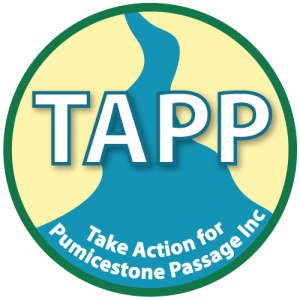Terrestrial Group (Scribe – Ben McMullen)
Table 1
Reintroduce the Coastal Emu to the catchment, by establishing a breeding program on the mainland to create a population that can be reintroduced to Bribie Island.
Work with the State government to establish an independent public process to evaluate the issues associated with 4WD use of the beach at Bribie Island and bring forward recommendations for long term management based on ESD principles, community aspirations and science.
Encourage/ facilitate the reestablishment of mangrove forests in areas where they used to exist – eg Golden Beach.
Undertake strategic restoration and enhancement of shorebird roost areas and support ongoing management with monitoring and data collection.
Undertake a contemporary assessment of the potential impacts on the community of Bribie Island and the mainland resulting from the harvesting of the pine forests on the island.
Undertake strategic restoration of ecological communities in areas east of the Bruce Highway that are not committed for “development”.
Improve fauna movement connections across through and under the linear infrastructure barriers that traverse the catchment (eg – major roads, power transmission lines and the rail line).
Increase the amount of monitoring effort for fauna across the catchment to improve the understanding of the population status and dynamics of fauna species.
Table 2
Draw on improvements in the understanding of landscape and ecological processes to inform management activities. For example – understanding the implications of interruptions to water flows and other natural processes.
Develop more comprehensive mapping for fauna and biodiversity values in the catchment (koalas in particular).
Develop more comprehensive mapping for cultural heritage values in the catchment.
Develop more comprehensive and rigorous hydrological catchment models to improve communication and education on water and land scapes; and improve decision making for restoration and conservation activities.
Table 3
Expand core areas and movement corridors for animals and plants.
Edge effects need to be better addresses in the network of conservation areas.
More pro-active management of threats to fauna is required (eg- ferrel predators, misinformed member of the public and domestic animals). This requires legislation that creates offences and a commitment to surveillance and enforcement.
Develop an environmental rangers program engaging young people.
All new infrastructure projects that generate enduring environmental impacts should be required to provide environmental offsets that are local, and adequate to the mitigation of the impact. The offsets should be provided in advance of the impact.
Table 4
Whenever impacts and mitigations for fauna are being considered, the same consideration should be given to flora.
Improvements in understanding are require across all stakeholders groups about the contribution that landscape features provide for ecosystem services. These may be achieved through improved dialogue and education. This is needed so that decisions will be made with a better appreciation of the costs associated with degrading environmental values, and the opportunities that are forgone when environmental values are degraded. Consideration should be given to how to better utilise local media providers to convey this type of information and the development of dynamic and compelling engagement activities.
Table 5
Identify and protect areas attributes and values that provide co-benefits to people, animals and plants.
Improve the contribution that urban environments give to broader environmental and human health outcomes.
Improve data collection on the efficacy of WSUD; Biophilic design (e.g Green Walls)
Improve the incorporation of traditional owners’ knowledge and practices into landscape and place management.
Table 6
Undertake a planning process to give clarity to the intended future use of lands on Bribie Island that are currently forested and are scheduled to be harvested.
Improve the protection of dune systems – by preventing additional encroachment on dunes from development and other uses.
Improve the management of flows through the catchment to reduce the pollution of water as it moves across the landscape. With a view to protecting the quality of water in the estuary and passage, and reducing the prevalence and impacts of problematic blooms (eg lyngbya).
Improve the monitoring of algae blooms and ecosystem processes to determine whether there maybe be technology enabled solutions for blooms.
Improve planning for and delivery of infrastructure that is required to meet the demands of increases in populations without causing increased impacts of the environment.
Key themes that emerged across the tables:
A landscape scale understanding and management of environmental values is required.
Restoration plans and activities need to be undertaken in a proactive fashion – rather than being adhoc or afterthoughts. They need to redress current environmental impacts as well as offsetting new ones.
Plant and animal species need to be further studied and investigated so that improved understanding can secure their conservation.
Improved monitoring is required for issues that are already significant in the environment and community context (eg lyngbya).
Connectivity between the current ecological features of the landscape needs to be improved.
Better engagement is required with traditional owners to improve knowledge and utilisation of their management approaches.
The tone and frequency of dialogue across the community and with decision makers, on environmental issues needs to improve, and provide the basis for increase knowledge sharing and collaborative management.
Soft solutions (solutions that mimic natural processes) are seen as being better for people, productivity and the environment than hard engineered ones.
Provision of infrastructure needs to address demands without causing residual impacts on people or natural systems.
